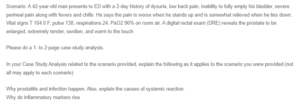Prostatitis and Systemic Inflammatory Response – Causes, Pathogens, and Immune Mechanisms
Prostatitis, Infection, and the Causes of Systemic Reaction
Prostatitis occurs due to an inflammatory process or infection of the prostate gland. It is categorized into acute bacterial prostatitis, chronic bacterial prostatitis, chronic pelvic pain syndrome, and asymptomatic inflammatory prostatitis (Maeda et al., 2023). In the acute form, such as the scenario described, it is often caused by a bacterial infection. Bacteria can enter the prostate gland through ascending urethral infection, spread from nearby organs, or through the bloodstream. Common pathogens involved are Escherichia coli, Klebsiella, Proteus, or other organisms (Walsh & Collyns, 2020). In this case, the patient’s symptoms of dysuria, low back pain, and severe perineal pain indicate an active infection that could have ascended from the urethra to the prostate. This led to the observed inflammation and swelling.
An elevated temperature, pulse rate, and respiratory rate characterize the systemic reaction seen in this case. This is known as systemic inflammatory response syndrome (SIRS). When the prostate gland is infected, it initiates an immune response. The release of pro-inflammatory cytokines stimulates the body’s defense mechanisms (Margraf et al., 2020). This cascade of events leads to the dilation of blood vessels, increased vascular permeability, and the migration of immune cells to the site of infection. These events cause the classical signs of inflammation, such as redness, warmth, and swelling. The release of these cytokines into the bloodstream contributes to the systemic symptoms observed. These include fever, elevated heart rate, and increased respiratory rate.
The body responds in this manner to combat the infection. However, the exaggerated response can lead to the manifestation of severe systemic symptoms (Margraf et al., 2020). The severe perineal pain and inability to fully empty the bladder, in this case, can be attributed to the localized inflammation and swelling of the prostate. This can obstruct the urethra and cause urinary retention and pain. The relief of pain when lying down is because positional changes affect the pressure on the prostate and influence pain perception.
Why Inflammatory Markers Rise
Inflammatory markers are essential components of the body’s immune response to various stimuli. This includes infection, injury, or autoimmune conditions. Examples of inflammatory markers are C-reactive protein (CRP), pro-inflammatory cytokines like interleukin-6 (IL-6), and erythrocyte sedimentation rate (ESR). When the body detects a potential threat like bacteria or viruses, it triggers a complex cascade of events aimed at defending and repairing tissues (Upadhyay et al., 2020). In response to the threat, immune cells release signaling molecules, including pro-inflammatory cytokines like IL-6. These cytokines act as alarm signals, alerting the body to the presence of a problem. They can also recruit other immune cells to the site of infection or injury. As a result, the immune system becomes activated and begins to release acute-phase proteins like CRP, which is produced primarily in the liver.
CRP helps to enhance the immune response and acts as a marker of inflammation. ESR is a blood test that measures the rate at which red blood cells settle in a tube. It tends to rise in the presence of inflammation. This is due to changes in the blood proteins that occur during inflammation. They cause red blood cells to aggregate and settle more quickly. Monitoring inflammatory markers is valuable in both diagnosing and managing inflammatory conditions: it enables healthcare professionals to assess the level of inflammation and tailor appropriate treatment strategies.
In the presented scenario, the patient is likely to have elevated inflammatory markers. On further investigation, his CRP and ESR levels might be increased. This could be due to inflammation of the prostate gland. The rise in inflammatory markers reflects the body’s immune response to the infection. These elevated markers aid in diagnosing and monitoring the severity of prostatitis. They will guide treatment choices, such as antibiotics, to resolve the infection and prevent possible complications.
References
Maeda, K., Shigemura, K., & Fujisawa, M. (2023). A review of current treatments for chronic prostatitis/chronic pelvic pain syndrome under the UPOINTS system. International Journal of Urology, 30(5), 431–436. https://doi.org/10.1111/iju.15149
Margraf, A., Ludwig, N., Zarbock, A., & Rossaint, J. (2020). Systemic inflammatory response syndrome after surgery: Mechanisms and protection. Anesthesia & Analgesia, 131(6), 1693–1707. https://doi.org/10.1213/ane.0000000000005175
Upadhyay, J., Tiwari, N., & Ansari, M. N. (2020). Role of inflammatory markers in coronavirus disease (COVID-19) patients: A review. Experimental Biology and Medicine, 245(15), 1368-1375. https://doi.org/10.1177/1535370220939477
Walsh, C., & Collyns, T. (2020). Pathophysiology of urinary tract infections. Surgery (Oxford), 38(4), 191-196. https://doi.org/10.1016/j.mpsur.2020.01.011
ORDER A PLAGIARISM-FREE PAPER HERE
We’ll write everything from scratch
Question

Prostatitis and Systemic Inflammatory Response
Scenario: A 42-year-old man presents to ED with a 2-day history of dysuria, low back pain, inability to fully empty his bladder, severe perineal pain along with fevers and chills. He says the pain is worse when he stands up and is somewhat relieved when he lies down. Vital signs T 104.0 F, pulse 138, respirations 24. PaO2 96% on room air. A digital rectal exam (DRE) reveals the prostate to be enlarged, extremely tender, swollen, and warm to the touch.
Please do a 1- to 2-page case study analysis.
In your Case Study Analysis related to the scenario provided, explain the following as it applies to the scenario you were provided (not all may apply to each scenario):
Why prostatitis and infection happen. Also, explain the causes of systemic reaction.
Why do inflammatory markers rise

